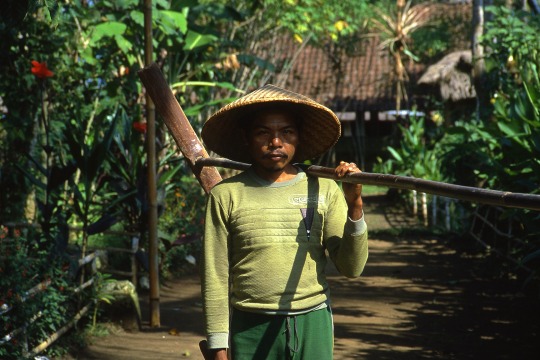 |
CULTURES IN CONTEXT Bali: Ancient and Modern 12. Rice Growing : 132-146 |

132. Farmers here typically start work around 4.00am, when it is cool; and they rest at home in the middle of the day before returning to the fields in the afternoon. |
133. Although the narrowest terraces will be worked by hand, most ploughing will be done with the help of cows. |
134. Cattle also pull the harrows used to level the surface after ploughing -- turning each field into a sea of mud. |
135. Seed has never been scattered in the fields here as it is in “the Developed World”. Instead people plant out seedlings raised in a nursery. Firstly, heads of grain selected from last year's crop are laid out in rows. |
136. These will sprout to produce rows of seedlings ready for transplantation in four or five weeks. |
137. The day on which they are planted is determined by the village committee in consultation with the priest, and offerings are made to the goddess of the rice fields. |
138. Young plants are then transferred to flat-bottomed baskets, which float. Taking a bunch of seedlings in his left hand, the farmer will plant them out individually with his right hand … at speed. |
139. The first nine seedlings in every field are planted at its centre in the form of a star pointing towards Mount Agung. The others are arranged in rows, one hand-span apart. Thereafter the rice will be watered and weeded, and offerings will be made to the rice goddess to protect the crop from insects. |
140. Forty-two days after the rice was planted out the farmer will celebrate its feast day with additional offerings. And when grain appears in the heads it is said to be pregnant. |
141. More offerings are made then. The water will be drained from the field, to speed up ripening, and people will be employed to scare away birds. |
142. The day on which the rice is cut will again be determined by the committee, and everyone helps harvest it … friends and neighbours, men, women and children. They will move in line as a team from one field to the next. Belonging to his family, his banjar, his subak, his temple and his village, every Balinese farmer lives a communal and corporate life that has no counterpart in the West. Those who help with the harvest receive a share of the crop as payment. |
143. Instead of a machine they use a small knife held between the fourth and fifth fingers of the right hand. The left hand is used to force the rice stalks against the blade of the knife. |
144. The severed heads of grain are grasped between the thumb and the first two fingers of the right hand. When the harvester's hand is full, these heads are passed to an assistant, who ties the bundles together into sheaves, which are grouped together in piles. |
145. These will be carried home later in the day and stored in a granary. When the farmer’s wife needs some grain she will dry a few bunches in the sun. |
146. She will loosen the grain by flailing the heads with a stick and use the wind to separate the grain from the chaff by winnowing as here. |
![]()
Text, photos and recordings
by John Tyman
Intended for Educational Use
Only.
Contact Dr. John Tyman at johntyman2@gmail.com
for information regarding public
or commercial use.
![]()
www.hillmanweb.com
Photo processing, Web page layout,
formatting and hosting by
William
Hillman ~ Brandon, Manitoba ~ Canada